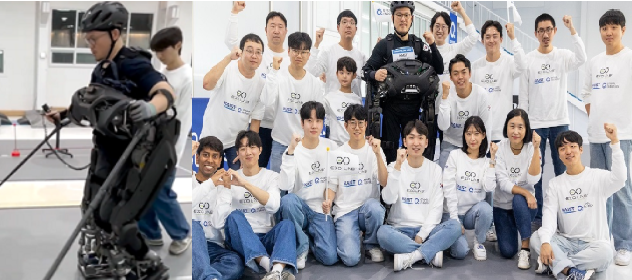
(Photo : https://www.kaist.ac.kr/en/)
KAIST's Breakthrough: Wearable Robot Aids Paraplegics
- South Korean researchers have developed a wearable robot, WalkON Suit F1, to assist paraplegic individuals in walking and climbing stairs.
- The robot, inspired by the movie "Iron Man", is equipped with sensors and lenses to maintain balance and analyze surroundings.
- Kim Seung-hwan, a paraplegic member of the team, demonstrated the prototype and won a gold medal at Cybathlon 2024 using the WalkON Suit F1.
- The development of WalkON Suit F1 is a significant milestone in assistive technology, offering a new level of independence to individuals with paraplegia.
In a groundbreaking development, researchers from South Korea have created a lightweight wearable robot that can assist paraplegic individuals in walking, navigating obstacles, and climbing stairs. This innovative technology, developed by the Exoskeleton Laboratory team at the Korea Advanced Institute of Science and Technology (KAIST), is designed to seamlessly integrate into the daily lives of individuals with disabilities. The team's mission is to create a robot that can be a part of the everyday lives of those with disabilities.
Revolutionizing Mobility for Paraplegics
The robot, named WalkON Suit F1, is a powered exoskeleton that can approach a user, even when they are seated in a wheelchair, and assist them in standing up. This feature is one of the most distinctive aspects of the robot, according to Kim Seung-hwan, a paraplegic member of the KAIST team. Kim demonstrated the prototype, which allowed him to walk at a speed of 3.2 kph (2 mph), climb a flight of stairs, and take sideways steps to slide into a bench. The WalkON Suit F1, composed of aluminium and titanium, weighs 50 kg (110 lb) and is powered by 12 electronic motors that mimic the movements of human joints while walking.
Inspired by 'Iron Man'
The inspiration for this revolutionary technology came from an unexpected source - the movie Iron Man. Park Jeong-su, another member of the KAIST team, was inspired by the film to create a robot that could assist people in real life. To ensure the user's balance while walking, the robot is equipped with sensors on its soles and in the upper body. These sensors monitor 1,000 signals per second and anticipate the user's intended movements. Lenses on the front of the robot function as eyes, analysing the surroundings, identifying the height of stairs, and detecting obstacles. This feature compensates for the lack of sensory ability of users with complete paraplegia, according to Park.
A Gold Medal Achievement
The WalkON Suit F1 has already proven its worth in a competitive setting. Kim Seung-hwan won the gold medal while wearing the WalkON Suit F1 in the exoskeleton category at Cybathlon 2024. This event saw developers with varying physical disabilities demonstrate assistive robots in eight categories. Kim's motivation for participating in the competition was deeply personal. He wanted to show his son that he used to be able to walk and share a diverse range of experiences with him. This sentiment underscores the profound impact that this technology can have on the lives of individuals with disabilities.
* This is a contributed article and this content does not necessarily represent the views of btin.co.in









